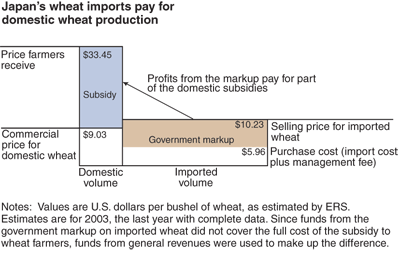Taxes on Imports Subsidize Wheat Production in Japan
- by John Dyck and Hisao Fukuda
- 2/1/2005
Despite high costs and poor milling quality, tens of thousands of Japan's farms grow wheat, usually on small fields, and production is rising. Government subsidies ensure that farmers receive at least $35 per bushel for their 2004 production, compared with an average of $3.35 expected for U.S. farmers. Wheat produced on large fields in the dry climates of North America, Australia, and Argentina is cheaper and of higher quality than Japan's wheat.
Japan's Ministry of Agriculture, Forestry and Fisheries (MAFF) pays farmers a subsidy per kilogram of wheat, with no limit on the amount of wheat. In 2004, that subsidy equated to $26/bushel. Farmers sell wheat commercially at market prices, currently $9 per bushel. The government then pays producers the subsidy through producer groups. In 2004, given expected output of 825,000 tons, the production subsidy cost over $700 million.
Much of Japan's production subsidy for wheat is financed by taxes on imports. Japan operates a tariff-rate quota (TRQ) for wheat imports, in which a higher tariff is imposed on all wheat imports that exceed a quota level. Japan's in-quota tariff for wheat is zero, while the over-quota tariff for wheat (and most, but not all, wheat products) is 55 yen/kg ($500/ton). The tariff raises the cost so much that it deters over-quota imports. MAFF, holding the sole right to import wheat within the TRQ, buys wheat at world prices and then sells the imported wheat to millers at a steep markup—almost 60 percent in 2003. The profit from this transaction (actually, a tax on imports) likely exceeds $450 million.
Thanks to these policies, Japan's annual wheat production exceeds 800,000 tons (roughly equal to output in Arkansas), most of which would otherwise be grown in other countries. The cost to Japan is high. Most of the subsidy simply covers farmers' high costs. Millers pay much more than the actual import costs for most of their basic input and are also forced to use lower quality domestic wheat. Millers pass their extra costs along to processors, retailers, and, ultimately, consumers.
Japan is under increasing budgetary and economic pressure to reconsider its wheat policies. In recent years, as production has risen, profits on imports have failed to cover subsidy costs. MAFF reports a growing deficit on the wheat account—about $345 million in 2003. Millers resist paying more for wheat—imported or domestic—because they face competition from imported wheat-containing products not included in the TRQ.
This article is drawn from:
- Fukuda, H., Dyck, J. & Stout, J. (2004). Wheat and Barley Policies in Japan. U.S. Department of Agriculture, Economic Research Service. WHS-04I01.


